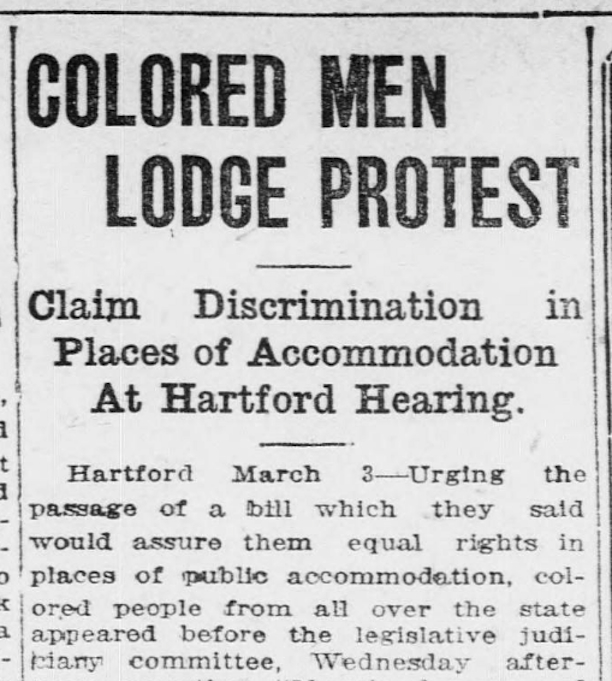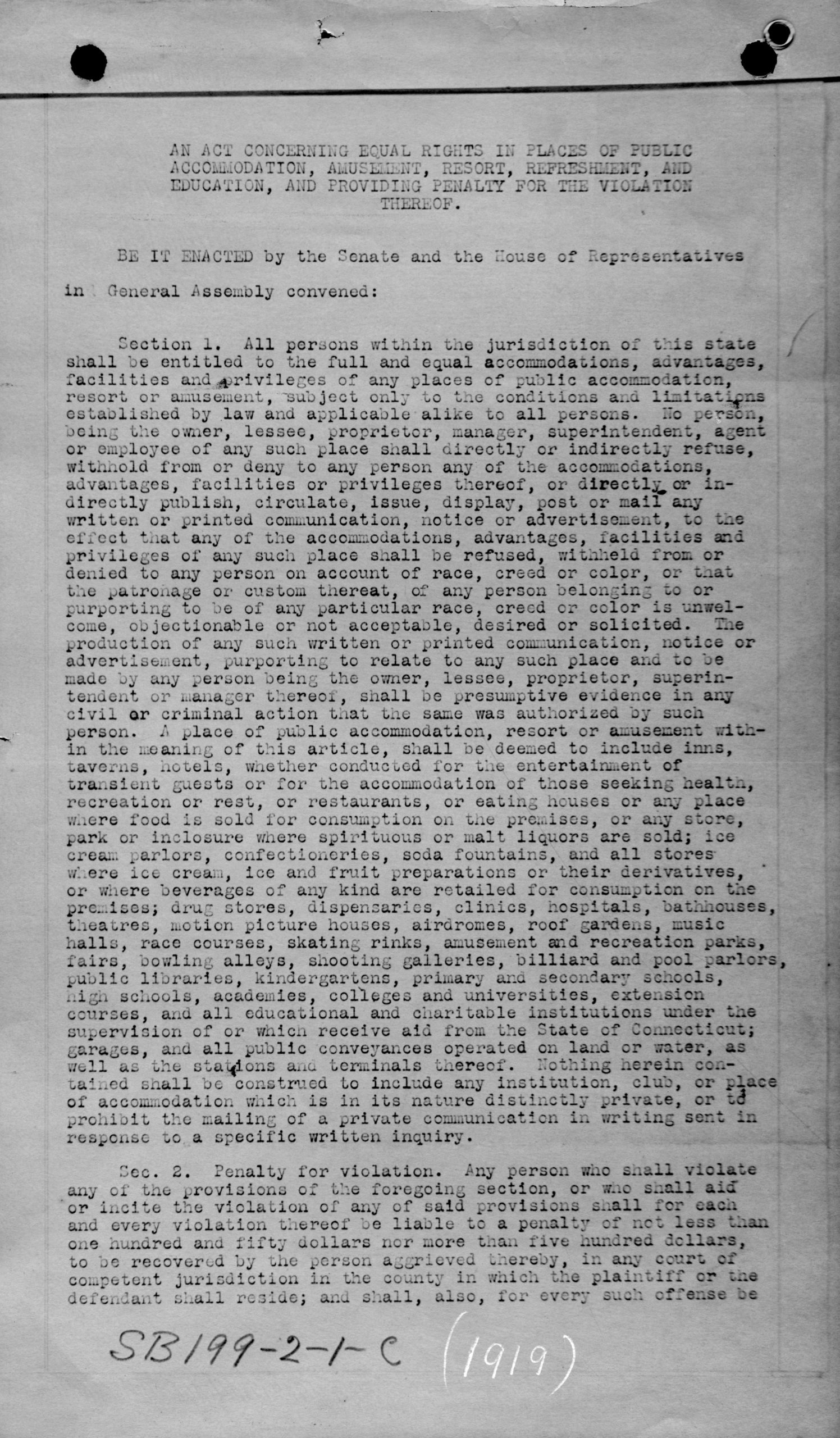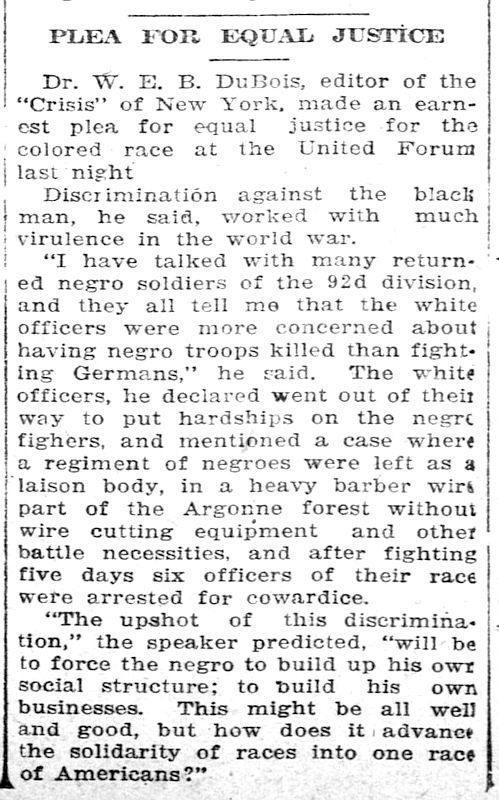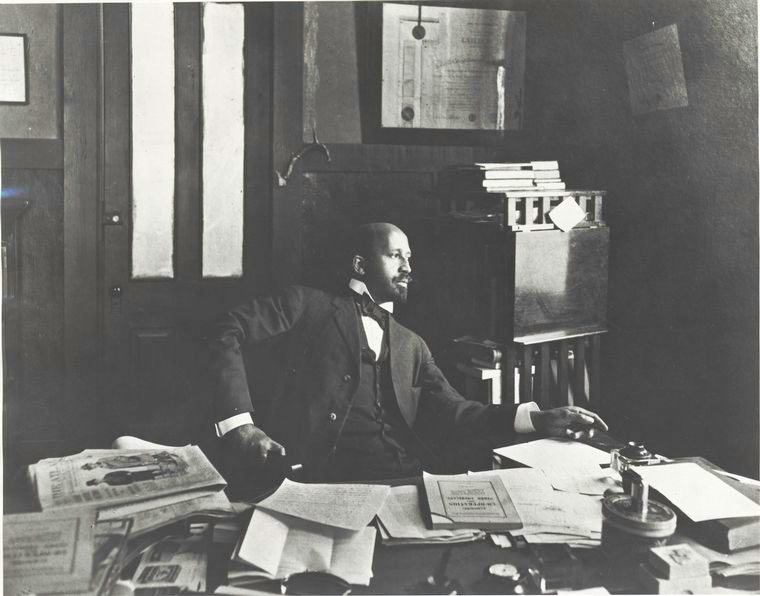by Christine Gauvreau, Project Coordinator, Connecticut Digital Newspaper Project
Connecticut State Library
TEACHER'S SNAPSHOT
Topics:
African Americans, Civil Rights, Military Service, Race, World War I
Town:
Bridgeport, Statewide
Grade:
High School
Historical Background
In the spring of 1919, black World War I veteran J. L. Morgan, accompanied by Connecticut African American leaders, appealed to the state legislature to grant his community equal access to “places of public accommodation” (facilities used by the public—hotels, restaurants, stores, parks, movie theaters, hospitals, etc.) and education. The proposed civil rights bill was defeated by both houses in April 1919.
D1: Potential Compelling Question
D1: POTENTIAL SUPPORTING QUESTIONS
- From the primary sources provided, what can you deduce about African Americans’ access to “places of public accommodation” (facilities used by the public—hotels, restaurants, stores, parks, movie theaters, hospitals, etc.) in Connecticut in 1919?
- What arguments for Connecticut Senate Bill 199 did its supporters present?
- Based on his 1920 speech in Bridgeport, Connecticut, what did W. E. B. Dubois believe the World War I experience meant for African Americans?
D2: TOOL KIT
Things you will need to teach this lesson:

“Colored Men Lodge Protest,” Bridgeport Times and Evening Farmer, March 3, 1919. Library of Congress, Chronicling America: Historic American Newspapers.

“An Act Concerning Equal Rights in Places of Public Accommodation, Amusement, Resort, Refreshment, and Education, and Providing Penalty for the Violation Thereof.” Photostat of page 1. Page 2 missing in bill room files, Connecticut State Library, SB 199-2-1-C (1919).

“Plea for Equal Justice,” Bridgeport Times and Evening Farmer, March 1, 1920. Library of Congress, Chronicling America: Historic American Newspapers.

“W. E. B. Dubois in the office of The Crisis.” New York Public Library Digital Collections.

Excerpted article by W. E. B. DuBois, “Returning Soldiers,” The Crisis, May 1919. Courtesy TeachingAmericanHistory.org.
D3: INQUIRY ACTIVITY
Have students read the first two sources (“Colored Men Lodge Protest” and page 1 of SB199) individually, with a partner, or as a class.
- What information can they gather from these sources?
- What can they deduce/infer about the civil rights of African Americans in Connecticut following World War I?
- What is the significance of the timing of the proposal of SB199 (immediately following World War I)?
- What questions do they have after reading the sources?
- How might students find answers to their questions?
For further inquiry, have students read W. E. B. DuBois, “Returning Soldiers,” The Crisis, May 1919 and “Plea for Equal Justice,” Bridgeport Times and Evening Farmer, March 1, 1920.
D4: COMMUNICATING CONCLUSIONS
- The legislative debate over SB199 (and even half of the text of the bill) is lost to us. Students will use what they have learned from the inquiry to complete the cut-off paragraph that begins at the bottom of page 1, in which penalties for denying access are spelled out. – OR – Students will create their own protest signs that might have been brought to the capitol in 1919. Signs should make a clear, catchy, historically accurate argument relevant to the bill.
- Students will research civil rights issues affecting veterans and members of the military today and use their new understanding of the historical context to enrich a letter to the editor or to legislators.
- Students will develop strategies or guidelines for identifying biases in newspaper accounts, both historical and contemporary, and then practice using these in future research and assignments.
ADDITIONAL RESOURCES
Place to GO
Things To DO
Have students use Library of Congress, Chronicling America: Historic American Newspapers to investigate how the post-World War I push for equality in public accommodations worked out in other states and compare it to Connecticut. Students should compare the coverage in mainstream commercial newspapers and in the African American press included in the database, as well as in Republican versus Democratic newspapers, rural and urban newspapers, and so on, whenever possible.
Websites to VISIT
Connecticut Digital Newspaper Project
ConnecticutHistory.org: World War I
Connecticut State Library: Remembering World War I
Connecticut State Library: World War I Veterans Database
Library of Congress: Guide to World War I Materials
Articles to READ
Connecticut Digital Newspaper Project:



